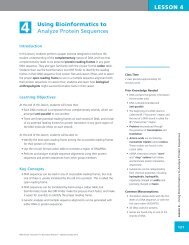WET LAB DNA Barcoding: From Samples to Sequences - Northwest ...
WET LAB DNA Barcoding: From Samples to Sequences - Northwest ...
WET LAB DNA Barcoding: From Samples to Sequences - Northwest ...
Create successful ePaper yourself
Turn your PDF publications into a flip-book with our unique Google optimized e-Paper software.
<strong>WET</strong> <strong>LAB</strong><br />
Obtaining <strong>Samples</strong> for <strong>DNA</strong> <strong>Barcoding</strong><br />
Any tissue sample that contains <strong>DNA</strong> can be used for <strong>DNA</strong> barcoding. However,<br />
certain types of samples are easier for students <strong>to</strong> work with than others.<br />
Suggested samples include:<br />
• Small pieces of fish or shellfish from a local grocery s<strong>to</strong>re, market, or<br />
restaurant.<br />
• Small pieces of meat (beef, pork, or poultry) from a local grocery s<strong>to</strong>re,<br />
market, or restaurant.<br />
• Insects, reptiles, amphibians, or fish (including immature life stages such as<br />
eggs, larva, or tadpoles), collected from local ecosystems, such as parks, lakes,<br />
or oceans.<br />
• Canned dog or cat food.<br />
• <strong>Samples</strong> obtained from zoos, aquariums, or wildlife parks. These are often<br />
called “convenience samples,” which are left over after being collected for<br />
routine veterinary exams.<br />
<strong>DNA</strong> can be purified from very small samples. The experiments below involve<br />
samples less than 25 milligrams (mg) in size – about half the size of a pencil<br />
eraser. While <strong>DNA</strong> is often purified from “raw” samples, <strong>DNA</strong> can be purified<br />
from cooked samples, such as canned meats, dog or cat food, or lef<strong>to</strong>ver meat<br />
from a meal at a restaurant.<br />
<strong>DNA</strong> barcoding has been used by students in New York City <strong>to</strong> determine<br />
whether seafood available at markets and restaurants is correctly labeled. Other<br />
projects include identification of wildlife in local parks or streams, and the meat<br />
components of canned pet food.<br />
<strong>Samples</strong> can be s<strong>to</strong>red in the refrigera<strong>to</strong>r (short-term, 1–3 days) or frozen<br />
until needed.<br />
<strong>LAB</strong> 1: <strong>DNA</strong> Purification for <strong>DNA</strong> <strong>Barcoding</strong><br />
Using Bioinformatics: Genetic Research<br />
<strong>DNA</strong> purification: Extracting the <strong>DNA</strong><br />
from a cell, and purifying it away from<br />
the remaining cellular components.<br />
Teacher Preparation<br />
• In advance of the labora<strong>to</strong>ry experiments, have students obtain samples for<br />
<strong>DNA</strong> purification (see Obtaining <strong>Samples</strong> for <strong>DNA</strong> <strong>Barcoding</strong> above).<br />
• Pre-heat the water bath or incuba<strong>to</strong>r <strong>to</strong> 55 °C. Depending upon the size of<br />
your water bath, this may take an hour or two, or even overnight.<br />
• Load the classroom computer with the Wet Lab PowerPoint slides.<br />
• Make copies of the Student Handout—<strong>DNA</strong> Purification for <strong>DNA</strong> <strong>Barcoding</strong>,<br />
one per student. These handouts are designed <strong>to</strong> be reused as a “class set.”<br />
Students should write their answers <strong>to</strong> questions and take notes on a separate<br />
sheet of paper or in their lab notebook, not directly on the handout.<br />
324<br />
©<strong>Northwest</strong> Association for Biomedical Research—Updated Oc<strong>to</strong>ber 2012
















